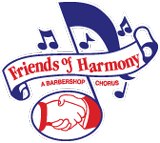The Friends of Harmony is Buffalo's premier 4-part a cappella mixed chorus singing in the Barbershop style. The Friends of Harmony were founded in 1983 and since our inception, we have strived to provide the finest in a cappella entertainment in Western New York.
Our director, Mike Woods, brings his choral directing experience and performing talent to the group and is growing our expertise in the barbershop style of singing and performing.
In 2024, the chorus achieved its highest score in competition in over 8 years!
Our award-winning chorus has represented the Seneca Land District at Barbershop Harmony Society international competitions many times over the past 40+ years.
Through our focus on the Barbershop style of a cappella chorus and quartet singing, we provide educational, musical, charitable, and administrative opportunities to our membership.
We maintain an enjoyable and supportive atmosphere, well suited for people of all backgrounds and good musical singing ability.
Our members provide a strong talent base enabling an active performance schedule and a successful competition status within our Society.
We hail primarily from the City of Buffalo and its suburbs and perform all over Western New York. We consist of male and female singers of all ages with varied musical abilities.
What is singing in the “Barbershop style”?
1. Four-Part Harmony (Without Instruments):
The music is sung a cappella (no instruments).
The four voice parts are:
Lead: Sings the melody (usually second highest).
Tenor: Harmonizes above the lead.
Baritone: Fills in the missing notes in the chord, sometimes above or below the lead.
Bass: Sings the lowest harmonizing notes.
2. "Barbershop Seventh" Chords (Dominant 7th Chords):
Barbershop heavily features dominant seventh chords, which give the genre its signature ringing, rich, and slightly bluesy sound.
About 30–40% of the music is made up of these chords.
3. Close Harmony & Voice Leading:
The harmonies are tight and close together, meaning the notes are often within a narrow range.
Voice leading is carefully designed to maximize resonance and smooth transitions between chords.
4. "Lock and Ring":
When sung precisely, the overtones created by the harmonic alignment cause a phenomenon called the "ring"—an audible overtone or phantom pitch that seems to hover above the group.
This "lock and ring" effect is a hallmark of great barbershop performance.
5. Homorhythmic Texture:
All voice parts generally move together rhythmically (known as homophony), which keeps the text clear and emphasizes harmonic blending.
6. Expressive Storytelling & Showmanship:
Barbershop emphasizes emotional delivery, facial expressions, and a strong connection to the lyrics.
Performers often use choreography and exaggerated facial expressions in competition settings.
7. Rooted in Tradition:
Originated in the late 1800s to early 1900s U.S., influenced by African American vocal traditions, gospel, spirituals, and early popular songs.
Revived in the 1930s with the formation of societies like the Barbershop Harmony Society (formerly SPEBSQSA).

